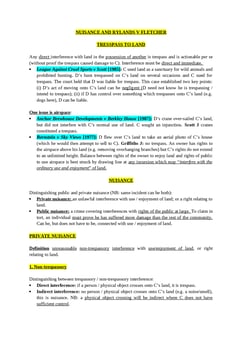Mullin v Richards [1998] 1 All ER 920
Judgement for the case Mullin v Richards
Table Of Contents
KEY POINTS
In the principles of negligence, the defendant has a duty to exercise care to prevent harm to the plaintiff, given the foreseeable nature of the accident.
In conditions where the game is not officially deemed dangerous by the school, the plaintiff's injury raises concerns about the defendant's actions and whether they fell short of the expected standard of care, particularly in a context involving minors.
FACTS
Two 15-year-old schoolgirls, Mullin (M) and Richards (R), were engaging in a fencing game using plastic rulers during a class. Unfortunately, one of the rulers snapped, and a piece of plastic entered M's right eye, resulting in the loss of all useful sight in that eye.
In response to the injury, M initiated legal proceedings for negligence against both R and the local education authority.
The trial judge dismissed the claim against the education authority but determined that both M and R had displayed negligence, with M's injury being a foreseeable consequence of their actions. Consequently, the judge ruled in favor of M's claim against R, albeit with a 50% reduction for contributory negligence on M's part.
R appealed this decision, arguing, among other points, that the judge had made an error in assessing foreseeability by not considering R's status as a non-adult.
JUDGEMENT
In negligence cases, the foreseeability test is usually objective. However, when the defendant is a child, the judge assesses whether a reasonable child of the same age, in the same situation, would have seen a risk.
In this case, the judge considered the ages of the parties correctly. Still, there was insufficient evidence to prove foreseeability. There was no history of similar rulers causing harm, no prohibition on playing with rulers at school, and no evidence of excessive violence during the game.
The incident was a typical schoolgirl's game, and there's no basis to expect participants to foresee a significant risk of injury. Consequently, the appeal was granted, and the judgment favored R.
COMMENTARY
In this negligence case, a 15-year-old plaintiff suffered an eye injury during a school game with another 15-year-old. Though not deemed dangerous or prohibited by the school, the game resulted in a snapped ruler, causing the injury.
The plaintiff sued both the defendant and the school authority for negligence. The judge found negligence on both sides, deeming the injury foreseeable, but reduced the plaintiff's claim by 50% for contributory negligence.
On appeal, a critical aspect emerged: negligence cases typically have an objective foreseeability test. However, when children are involved, the judge must assess whether a reasonable child of the same age and situation would perceive a similar risk.
While the judge appropriately considered the ages of the parties, the appeal succeeded due to insufficient evidence of foreseeability. There was no prior history of ruler-related injuries, no school prohibition on such games, and no evidence of excessive violence.
It was deemed a typical school game, and foreseeing a significant injury risk was unwarranted. As a result, the appeal favored the defendant, R.
ORIGINAL ANALYSIS
2 girls were mock-fighting with rulers and Plaintiff’s ruler smashed, getting glass in Defendant’s eye.
She sued Defendant for negligence.
-
CA said that the test of reasonable foreseeability, proximity and fair, just and reasonable.
However what was “reasonably foreseeable” was considered by reference to age and sex.
In this case, although it was reasonably foreseeable to an adult that Defendant might get injured, it was not reasonably foreseeable to a 15 year old girl. “Reasonable” is to be considered in the context of age and sex.
This makes the test less objective. They could also have used the “horseplay” excuse of Blake v Galloway.
RELATED CASES
For Further Study on Mullin v Richards
Need instant answers? Our AI exam tutor is here to help.
Ask questions 🙋 Get answers 📔 It's simple 👁️👄👁️
Our AI is educated by the highest scoring students across all subjects and schools. Join hundreds of your peers today.
Get StartedSimilar Cases
Related Product Samples
These product samples contain the same concepts we cover in this case.
| Tort Law | Negligence Duty Of Care Notes (35 pages) |

 Since 2010, Oxbridge Notes has been a trusted education marketplace, supplying high-quality materials from top achievers at universities like Oxford, Cambridge, LSE, Harvard, and Yale.
Since 2010, Oxbridge Notes has been a trusted education marketplace, supplying high-quality materials from top achievers at universities like Oxford, Cambridge, LSE, Harvard, and Yale.